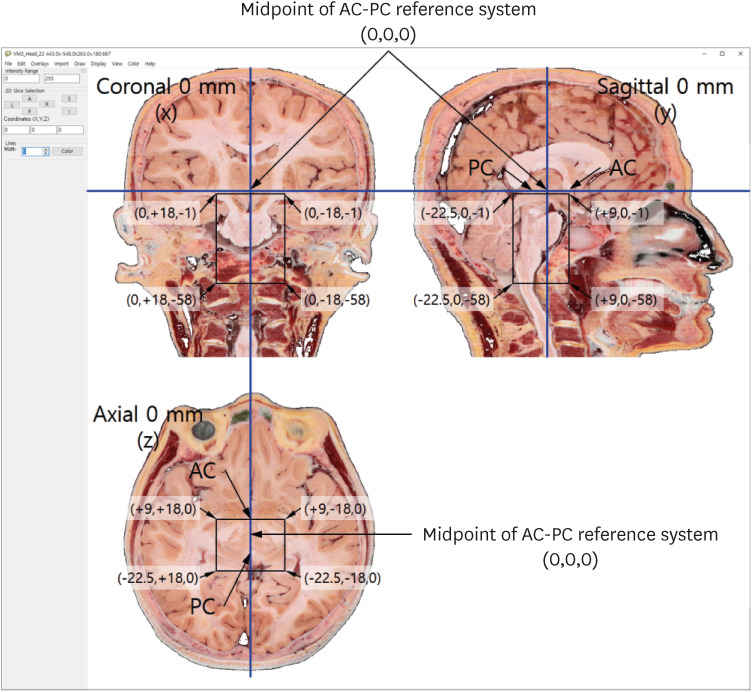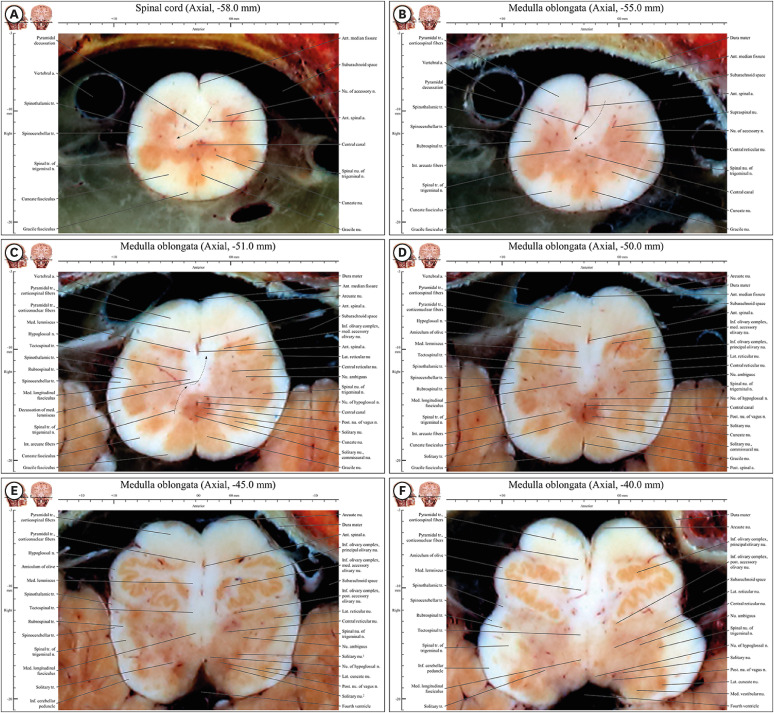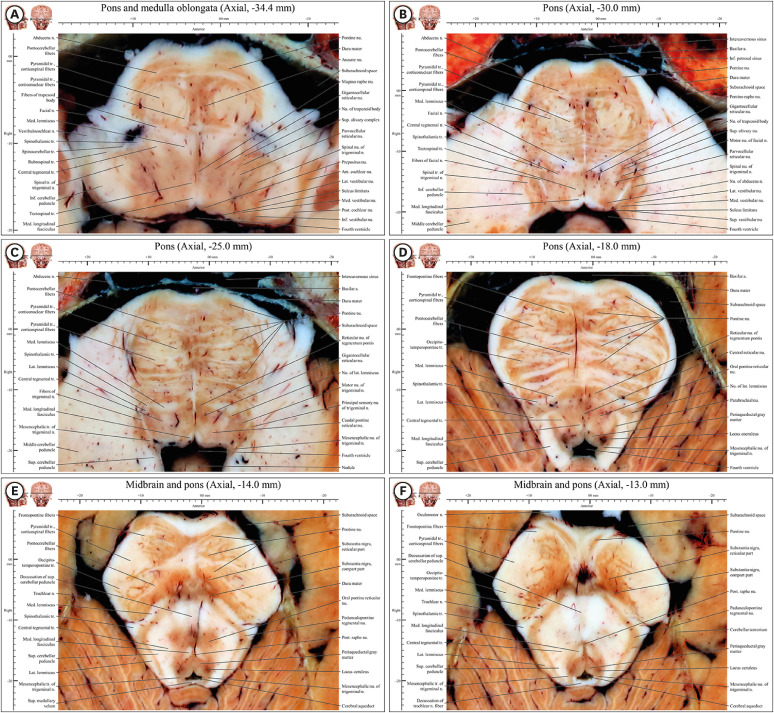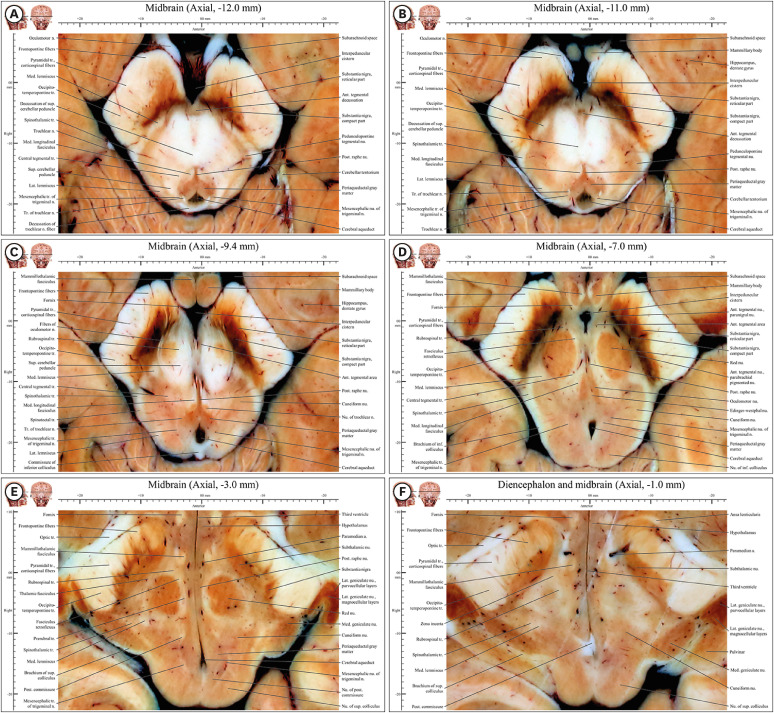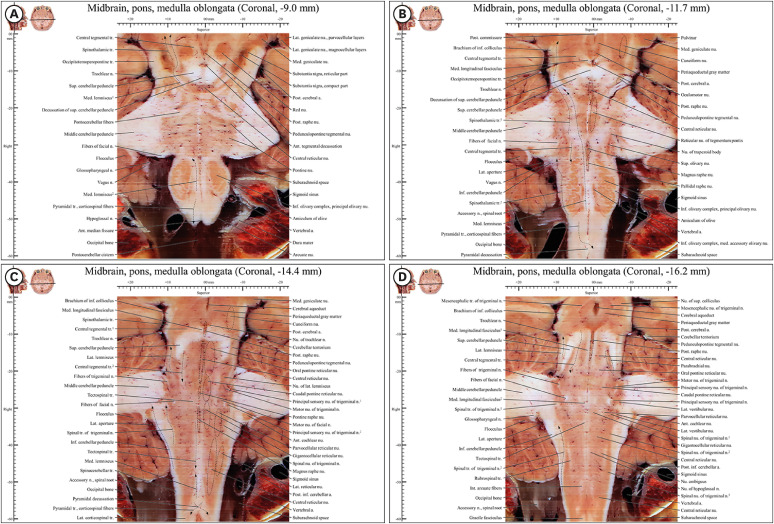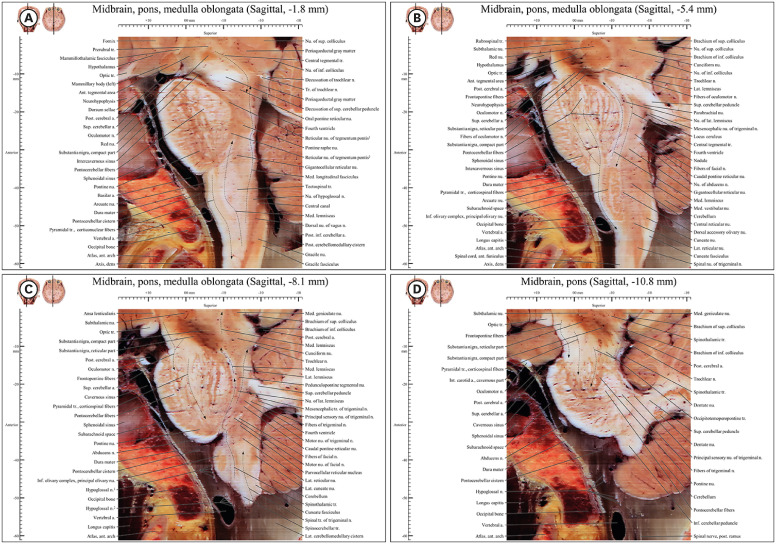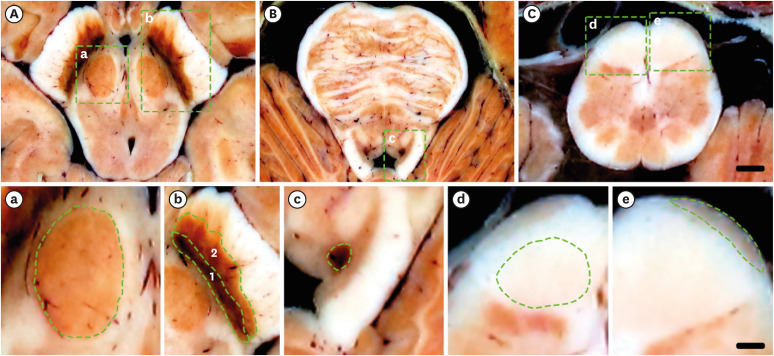J Korean Med Sci.
2023 Mar;38(10):e76. 10.3346/jkms.2023.38.e76.
A Novel Human Brainstem Map Based on True-Color Sectioned Images
- Affiliations
-
- 1Department of Anatomy, Dongguk University School of Medicine, Gyeongju, Korea
- KMID: 2540426
- DOI: http://doi.org/10.3346/jkms.2023.38.e76
Abstract
- Background
Existing atlases for the human brainstem were generated from magnetic resonance images or traditional histologically stained slides, but both are insufficient for the identification of detailed brainstem structures at uniform intervals.
Methods
A total of 319 sectioned images of the brainstem were selected from whole-body axial sectioned images, then coronal and sagittal sectioned images were reconstructed from the horizontal images. The fine and detailed structures were annotated in PowerPoint slides, then the volume model was produced and some white matter fibers were traced using MRIcroGL.
Results
In this study, a novel brainstem atlas based on sectioned images was generated that shows the true color and shape, as well as the accurate location of the nuclei and tracts; it reveals the striking contrast between gray and white matter, as well as fine structures. In total, 212 structures, including nuclei and tracts, were annotated in axial, coronal, and sagittal plane views of sectioned images (48-bit true color; 0.2 mm intervals, 0.06 mm × 0.06 mm pixel size). To verify the accuracy of the annotations, a volume model of the brainstem was constructed for independent observations of the three planes.
Conclusion
In this paper, we describe several interesting structures included in the atlas. By depicting the fine structures of the human brainstem in detail, this atlas allows comprehensive understanding of the complicated topographies of the brainstem. As such, it will be of value for neuroanatomy education and research, in addition to enriching the literature on the human brain.
Figure
Cited by 1 articles
-
Lymph Node Stations of Pancreas Which Are Identified in Real Color Sectioned Images of a Cadaver With Pancreatic Cancer
Chung Yoh Kim, Yongwook Jung, Jin Seo Park
J Korean Med Sci. 2023;38(46):e392. doi: 10.3346/jkms.2023.38.e392.
Reference
-
1. Carpenter MB, Sutin J. Human Neuroanatomy. 8th ed. Baltimore, MD, USA: Williams & Wilkins;1983.2. Noback CR, Strominger NL, Demarest RJ, Ruggiero DA. Brainstem: medulla, pons, and midbrain. Noback CR, Strominger NL, Demarest RJ, Ruggiero DA, editors. The Human Nervous System: Structure and Function. Totowa, NJ, USA: Humana Press;2005. p. 219–242.3. Donaldson SS, Laningham F, Fisher PG. Advances toward an understanding of brainstem gliomas. J Clin Oncol. 2006; 24(8):1266–1272. PMID: 16525181.4. Adil SM, Calabrese E, Charalambous LT, Cook JJ, Rahimpour S, Atik AF, et al. A high-resolution interactive atlas of the human brainstem using magnetic resonance imaging. Neuroimage. 2021; 237:118135. PMID: 33951517.5. Bianciardi M, Toschi N, Eichner C, Polimeni JR, Setsompop K, Brown EN, et al. In vivo functional connectome of human brainstem nuclei of the ascending arousal, autonomic, and motor systems by high spatial resolution 7-Tesla fMRI. Magn Reson Mater Biol Phys Med. 2016; 29(3):451–462.6. Nguyen TH, Vaussy A, Le Gaudu V, Aboab J, Espinoza S, Curajos I, et al. The brainstem in multiple sclerosis: MR identification of tracts and nuclei damage. Insights Imaging. 2021; 12(1):151. PMID: 34674050.7. Rushmore RJ, Wilson-Braun P, Papadimitriou G, Ng I, Rathi Y, Zhang F, et al. 3D exploration of the brainstem in 50-micron resolution MRI. Front Neuroanat. 2020; 14:40. PMID: 33071761.8. Singh K, Cauzzo S, García-Gomar MG, Stauder M, Vanello N, Passino C, et al. Functional connectome of arousal and motor brainstem nuclei in living humans by 7 Tesla resting-state fMRI. Neuroimage. 2022; 249:118865. PMID: 35031472.9. Coulombe V, Saikali S, Goetz L, Takech MA, Philippe É, Parent A, et al. A topographic atlas of the human brainstem in the ponto-mesencephalic junction plane. Front Neuroanat. 2021; 15:627656. PMID: 34483849.10. DeArmond SJ, Fusco MM, Dewey MM. Structure of the Human Brain: A Photographic Atlas. 3rd ed. New York, NY, USA: Oxford University Press, Inc.;1989.11. Leigh RJ. From Nissl stains to modern concepts of brainstem function. Brain. 2014; 138(2):501–503.12. Sclocco R, Beissner F, Bianciardi M, Polimeni JR, Napadow V. Challenges and opportunities for brainstem neuroimaging with ultrahigh field MRI. Neuroimage. 2018; 168:412–426. PMID: 28232189.13. Naidich TP, Duvernoy HM, Delman BN, Sorensen AG, Kollias SS, Haacke EM. Duvernoy's Atlas of the Human Brain Stem and Cerebellum: High-Field MRI, Surface Anatomy, Internal Structure, Vascularization and 3 D Sectional Anatomy. Berlin, Germany: Springer Verlag;2009.14. Talairach J, Tournoux P. Co-Planar Stereotaxic Atlas of the Human Brain: 3-Dimensional Proportional System: An Approach to Cerebral Imaging. 1st ed. Stuttgart, Germany: Thieme Stuttgart;1988.15. Park JS, Chung MS, Park HS, Shin DS, Har DH, Cho ZH, et al. A proposal of new reference system for the standard axial, sagittal, coronal planes of brain based on the serially-sectioned images. J Korean Med Sci. 2010; 25(1):135–141. PMID: 20052359.16. You Y, Kim CY, Kim SK, Chung BS, Har D, Choi J, et al. Advanced-sectioned images obtained by microsectioning of the entire male body. Clin Anat. 2022; 35(1):79–86. PMID: 34591338.17. Park JS, Chung MS, Hwang SB, Lee YS, Har DH, Park HS. Visible Korean human: improved serially sectioned images of the entire body. IEEE Trans Med Imaging. 2005; 24(3):352–360. PMID: 15754985.18. Chung BS, Park JS. Real-color volume models made from real-color sectioned images of Visible Korean. J Korean Med Sci. 2019; 34(10):e86. PMID: 30886552.19. Paxinos G, Huang XF. Atlas of the Human Brainstem. San Diego, CA, USA: Elsevier Inc.;1995.20. Federative Committee on Anatomical Terminology. Terminologia Anatomica: International Anatomical Terminology. 1st ed. New York, NY, USA: Thieme;1998.21. Kiernan JA, Rajakumar R. Barr’s the Human Nervous System: An Anatomical Viewpoint. 10th ed. Philadelphia, PA, USA: Lippincott Williams & Wilkins;2004.22. Park HS, Chung MS, Shin DS, Jung YW, Park JS. Accessible and informative sectioned images, color-coded images, and surface models of the ear. Anat Rec (Hoboken). 2013; 296(8):1180–1186. PMID: 23713007.23. Park HS, Chung MS, Shin DS, Jung YW, Park JS. Whole courses of the oculomotor, trochlear, and abducens nerves, identified in sectioned images and surface models. Anat Rec (Hoboken). 2015; 298(2):436–443. PMID: 25212480.
- Full Text Links
- Actions
-
Cited
- CITED
-
- Close
- Share
- Similar articles
-
- Lymph Node Stations of Pancreas Which Are Identified in Real Color Sectioned Images of a Cadaver With Pancreatic Cancer
- Serial Slice Images and Segmented Images of the Brainstem for Recognizing the Stereoscopic Morphology of its Nuclei and Tracts
- Automated Techniques for the Sectioned Images of Visible Korean
- Dawn of the Visible Monkey: Segmentation of the Rhesus Monkey for 2D and 3D Applications
- Registration of Cadaver's Sectioned Images to Patient's Head MRIs

